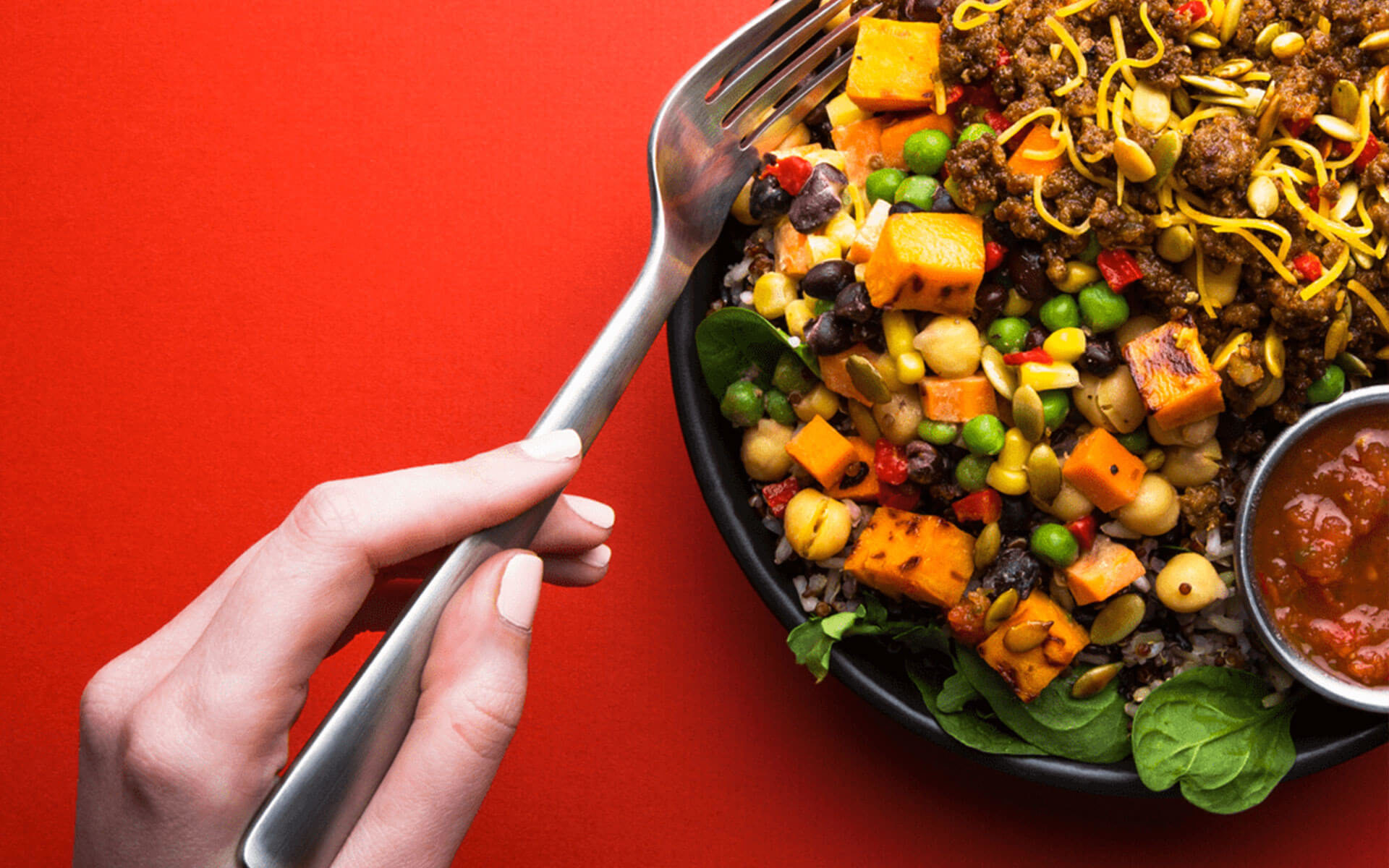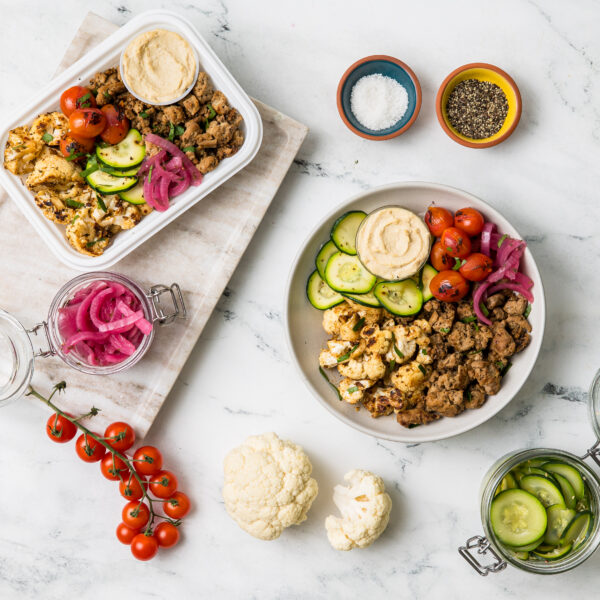Here at Snap, one of our top priorities is providing delicious, quality food without cutting any corners. That includes how and where we source our ingredients! We’re proud to say that all of our beef is 100% grass-fed and grass-finished. You might be wondering what that even means, and what makes grass-fed beef different than grain-fed. Today, let’s break it down!
But first, curious where ours comes from? Our ground beef is from different local farms (dependent on whether you’re shopping in our TX or Philly market). Our steak is from Verde Farms, a farm with a mission & quality standards that we can get behind!
what does it mean for cattle to be grass-fed & grass-finished?
While many cows begin their lives on pasture (aka grass) for the first few months, far less stay there for the duration of their lives. After the first few months of life, grass-fed cows have a much different fate than grain-fed ones. Grain-fed cows head to a Concentrated Animal Feeding Operation (CAFO or feedlot) where they live in close quarters with many other cows and are fed soy-and-grain-based feed in order to fatten up before slaughter. Some cows are born into feedlots and never see time on pasture. To manage illness and disease given the close quarters, infected cows are often treated with antibiotics, and many cows are treated with hormones to help increase their growth. While the demand for grass-fed beef is growing, the vast majority of cows are either sent to feedlots or born on one.
Conversely, the small amount of cows that stay on grass for their entire lives are considered 100% grass-fed and grass-finished. These cows are able to forage for grass, clover and other plants that are a part of their natural diet. Cows are ruminants, and they thrive when they’re eating what nature intended. There is also less need for antibiotics with grass-fed cows, since these animals are living in more natural conditions with more space.
what makes grass-fed beef different than grain-fed beef?
Whether beef is grass-fed or grain-fed, it is filled with vitamins B12, B3 and B6 as well as iron, selenium and zinc. Beef actually contains most of the nutrients people need to survive! Grass-fed beef is nutritionally superior to grain-fed beef in a few important ways, though. Compared to traditional grain-fed beef, grass-fed beef:
- contains up to five times more omega-3 fats. This is huge! Omega-3 fats can help decrease inflammation, decrease risk of heart disease, improve mental well-being and improve focus. Cows who finish out their lives in a feedlot lose most of the beneficial omega-3 fats that they had stored while on pasture. Most Americans don’t consume enough omega-3 fats, so grass-fed beef is one way to remedy that. Other sources of omega-3 fats include salmon, mackarel, sardines, chia seeds and walnuts.
- contains twice as much CLA (conjugated linoleic acid). Some sources put this number even higher, saying grass-fed animal products can contain between three to five times as much CLA as grain-fed animals. Meat and dairy from grass-fed animals is the main source of CLA in our diets. CLA has numerous health benefits, including helping to decrease cancer risk, fighting inflammation and boosting the immune system, as well as helping with weight loss.
- is better for the environment. While cattle are often blamed for releasing methane gas and contributing to global warming, it’s actually the way that cattle are raised that’s to blame. Cattle raised on rotating pasture land (aka moving to new pasture on a regular basis) actually helps contribute to a net carbon sink, meaning the methane emissions from cow manure is offset by the amount of carbon sequestered into the ground. Cool stuff!
- is lower in fat and in turn lower in total calories. A six ounce portion of grass-fed beef has about 100 fewer calories than a six ounce portion of grain-fed beef. Over the course of the year, just switching from grain-fed beef to grass-fed beef can save you thousands of calories! If tracking macros or calories is your jam, this is great news!
- has higher amounts of vitamin A and vitamin E. Grass-fed beef contains precursors to vitamin A, such as beta-carotene. Vitamin A has numerous health benefits, including protecting eye health, supporting a healthy immune system, and supporting bone health. Vitamin E is an antioxidant that protects your cell membranes from oxidation (a good thing!). It can also help support eye & immune health, as well as reduce inflammation and decrease cancer risk.
Whew! That’s quite a few awesome benefits. While it may seem like all meat is created equal, how an animal is raised can have quite the impact on its overall nutrient density and environmental impact.
where can you find grass-fed beef?
Aside from here at Snap Kitchen, you have a few options when it comes to finding grass-fed beef near you. If you have a health food store nearby, you can search for 100% grass-fed and grass finished labels on beef. If you can find products labeled with the seal of American Grassfed Association (AGA) or American Food Alliance (AFA), that’s a bonus. The AGA and AFA are two organizations that actually have stricter grass-fed requirements than the USDA. Unfortunately, marketing words like ‘natural’ or ‘free-range’ won’t help you find grass-fed or pasture-raised meats.
Another option is to find a local farmer or farmer’s market in your area. You can google ‘grass-fed meats + your area’ or ‘pasture-raised meats + your area’ to find farmers, or use a website like eatwild.com and plug in your zip code. Not only does local meat have less distance to travel and enable you to support the local economy, but you can also ask the farmer questions about how they raise their animals.
Have more questions about grass-fed beef? Post them in the comments!
Want help along the way? Try one of our Snap Kitchen for dietitian-curated, chef-prepared meals delivered to your door.





Leave a Reply
2 Comments
Thank you for crucially explaining the difference between grass fed vs grass finished beef!
Healthy Happy cow = Healthy Happy Human:)
Thank you for sharing the great advantages of eating grassfed beef.